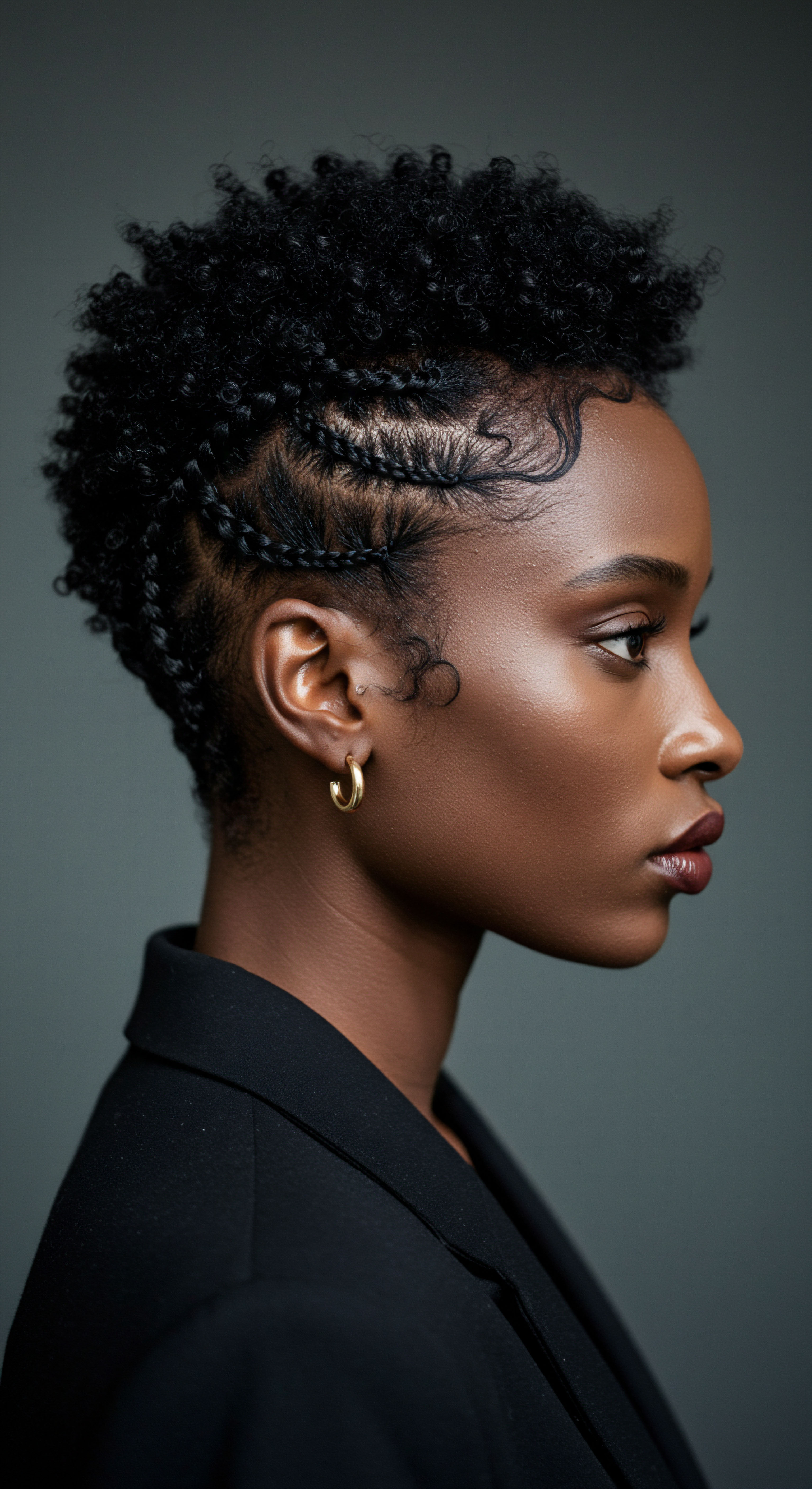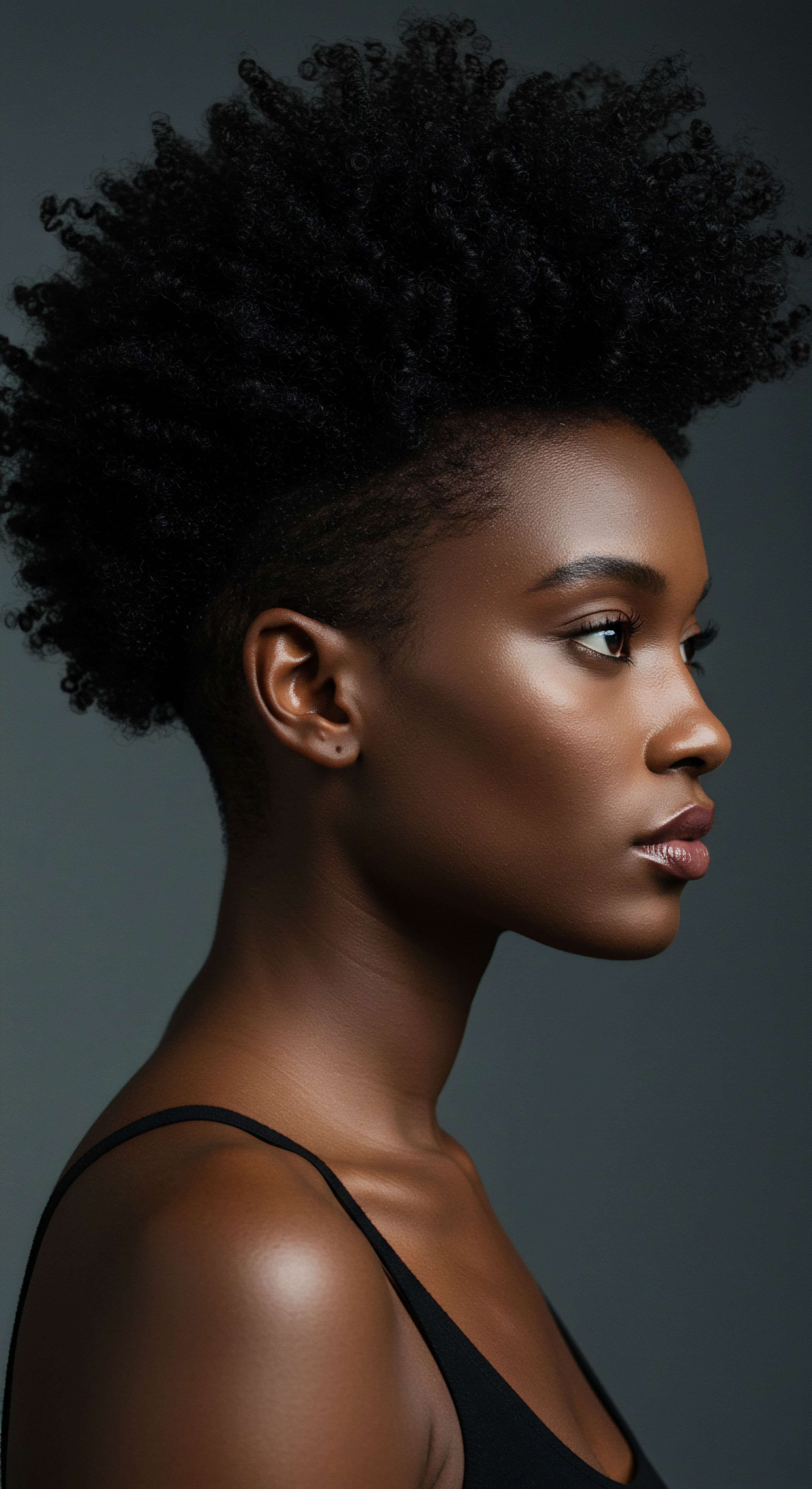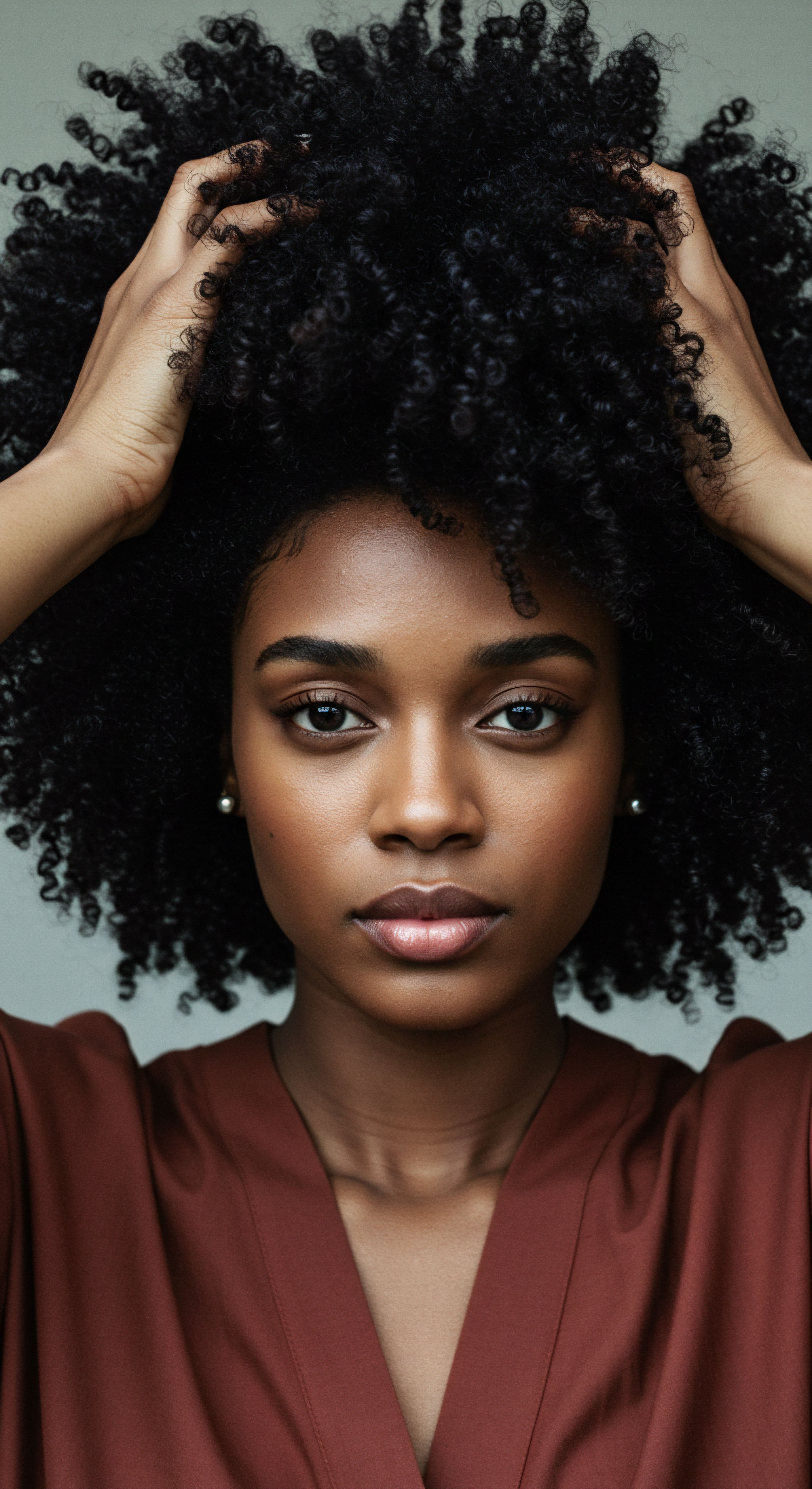
Roots
Consider for a moment the profound intimacy of night, a time when the world quiets, and we surrender to rest. For those graced with the spirited coil and curl of textured hair, this period holds a delicate balance. It is a time when the hair, often a crown of identity and heritage, meets the silent adversary of friction.
This nightly interaction, seemingly benign, wields considerable influence over the vitality and resilience of these unique strands. Understanding this dynamic begins with a deeper look at the very make-up of textured hair and the subtle ways it interacts with the world around it, especially during our hours of repose.

Hair Anatomy and Its Distinctive Features
Each strand of hair, a marvel of biological engineering, comprises several layers. The outermost, the Cuticle, resembles overlapping shingles on a roof, offering protection to the inner cortex. For straight hair, these cuticles tend to lie flat, creating a smooth surface. However, the architecture of curly and coily hair is inherently different.
The elliptical or flattened cross-section of these hair types, combined with their characteristic bends and twists, means the cuticle layers often do not lie as uniformly flat. This natural lifting of the cuticle scales, while contributing to the hair’s beautiful volume and texture, also renders it more susceptible to external influences.
This unique structure also presents a challenge for the natural oils, known as Sebum, produced by the scalp. Sebum, a protective and conditioning agent, finds it more difficult to travel down the winding path of a curly or coily strand to coat its entire length. This inherent difficulty often results in textured hair being naturally drier than its straighter counterparts. When dryness couples with external stressors, the hair’s vulnerability increases significantly.

The Silent Abrasion of Sleep
As we drift into sleep, our movements, however slight, introduce a continuous mechanical rubbing of hair against the pillowcase. This seemingly innocuous contact, repeated nightly, initiates a process of abrasion. For hair with its already raised cuticle scales, this friction acts as a persistent aggressor, further lifting and even chipping away at these protective layers. The result is a compromised outer barrier, leaving the delicate inner cortex exposed.
Beyond the direct physical wear, this constant friction generates Static Electricity. Anyone with textured hair knows the phenomenon of hair standing on end or forming a halo of unruly strands, particularly in dry environments. This static, a direct consequence of friction, can exacerbate frizz and disrupt the natural curl pattern, making morning styling a more arduous task. The cumulative effect of this nightly agitation can be observed as increased frizz, a loss of curl definition, and the unwelcome appearance of split ends.

Moisture’s Quiet Departure
Compounding the mechanical damage is the issue of moisture loss. Many traditional pillowcase materials, such as cotton, are highly absorbent. They act like thirsty sponges, drawing essential hydration not only from the skin but also from the hair strands. For textured hair, which already struggles with distributing its natural oils and retaining moisture due to its structure, this absorption by bedding can be particularly detrimental.
The loss of moisture renders the hair more brittle and less pliable. When hair is dry, its susceptibility to breakage increases significantly. The combination of cuticle damage from friction and dehydration from absorbent fabrics creates a cycle of vulnerability, where hair becomes progressively weaker, more prone to tangling, and ultimately, breakage. This fundamental understanding sets the stage for appreciating the profound impact of sleep friction.
The nightly interaction of textured hair with sleep surfaces significantly influences its vitality, with friction and moisture loss posing primary challenges.

Ritual
Having considered the underlying anatomy and the fundamental ways sleep surfaces interact with textured hair, our attention now turns to the practical wisdom that can transform nightly rest into a period of restorative care. This involves a conscious shift from passive exposure to active protection, embracing practices that safeguard the hair’s delicate structure and preserve its inherent moisture. It is a commitment to a ritual, a thoughtful sequence of steps that honor the unique needs of curls and coils, ensuring they greet the morning with resilience.

Choosing the Right Sleep Surface
The material of your pillowcase holds considerable sway over the hair’s condition by morning. Traditional cotton, with its woven fibers, creates a rough surface that snags and pulls at the hair strands. This friction, as discussed, lifts the cuticle and contributes to frizz and breakage. Cotton’s absorbent nature further strips hair of its much-needed moisture.
In contrast, silk and satin offer a smoother, more forgiving surface. These materials allow hair to glide effortlessly, drastically reducing mechanical friction. This reduction in friction helps keep the cuticle layers flat, minimizing frizz and preventing tangles. Furthermore, silk and satin are far less absorbent than cotton, meaning they help the hair retain its natural moisture and any applied products throughout the night.
A study published in the Journal of Cosmetic Dermatology indicated that the smooth surface of silk pillowcases can reduce hair friction by up to 43% compared to other fabrics. This scientific backing underscores the tangible benefits of making such a seemingly simple switch. While silk is a natural protein fiber, satin refers to the weave, which can be made from silk or synthetic materials like polyester. For hair benefits, the smooth weave is the primary advantage, though pure silk offers additional benefits like breathability and temperature regulation.

Protective Styles for Nighttime
Beyond the pillowcase, the way hair is arranged before sleep provides an additional layer of defense against friction and tangling. These protective styles minimize movement and contact with surfaces, thereby preserving curl definition and reducing breakage.
- Pineappling ❉ This widely practiced technique involves gathering hair loosely at the very top of the head, secured with a soft scrunchie or ribbon. The aim is to allow the curls to fall forward, minimizing flattening and friction against the pillow. It is particularly well-suited for longer or more voluminous hair.
- Loose Braids or Twists ❉ For those with medium to long hair, loose braids or twists can be an excellent choice. These styles keep hair contained, preventing tangles and reducing surface area exposed to friction. The key is to avoid tightness, which can cause tension at the scalp and lead to breakage.
- Bantu Knots ❉ A traditional African hairstyle, Bantu knots involve twisting sections of hair and coiling them into small, secure buns. This style offers exceptional protection for tighter curls and coily hair, preserving definition and minimizing friction.

The Role of Hair Bonnets and Scarves
For many with textured hair, a bonnet or scarf is not merely an accessory; it is an essential part of a nightly care ritual, steeped in cultural significance and practical wisdom. These head coverings, traditionally made from satin or silk, encapsulate the hair, creating a barrier against friction and preserving moisture.
The historical context of hair bonnets in African American culture, for example, speaks volumes about their importance. During times of immense hardship, bonnets served as a practical solution to protect hair from harsh conditions and limited care resources, simultaneously becoming a symbol of resilience and identity. This practice continues today, recognizing the bonnet’s efficacy in maintaining styles, reducing the need for frequent manipulation, and thus minimizing damage.
When selecting a bonnet or scarf, the material is paramount. Satin or silk options are preferred for their smooth surface, which allows hair to glide without snagging or absorbing moisture. This ensures that the hair remains hydrated and its curl pattern undisturbed through the night.
Conscious choices in sleep surfaces and protective styling are essential, with silk or satin materials and gentle hair arrangements safeguarding against friction and moisture loss.

Relay
Beyond the immediate concerns of nightly friction and moisture retention, a more profound understanding of textured hair health calls for a deeper exploration, one that intertwines scientific principles with cultural continuity and the broader implications of care. How does the cumulative effect of seemingly small nightly abrasions truly alter the hair’s very architecture, and what historical echoes shape our modern practices of protection? This section seeks to bridge the empirical observations with a more comprehensive perspective, inviting a reflective consideration of textured hair’s resilience and vulnerability.

The Microscopic Alterations of Friction
The impact of sleep friction extends beyond visible frizz or tangles; it initiates changes at the microscopic level of the hair shaft. When the hair’s outer cuticle, composed of overlapping keratin scales, is repeatedly rubbed against a rough surface, these scales become raised, chipped, or even removed. This damage is akin to stripping the protective sealant from a delicate surface.
Once the cuticle is compromised, the hair’s internal structure, particularly the Cortex, becomes exposed. The cortex contains the majority of the hair’s mass, including the proteins that dictate its strength, elasticity, and natural curl pattern. A damaged cuticle allows for accelerated moisture evaporation from the cortex, leading to dehydration. This desiccation makes the hair stiff and brittle, significantly increasing its susceptibility to breakage under even minimal stress.
Furthermore, friction can lead to the formation of internal cracks within the hair fiber. Research investigating hair breakage mechanisms in African-American hair, for instance, has proposed a sequence of events ❉ cuticle sliding, followed by failure at the cuticle-cortex interface, then the nucleation and growth of intercellular cracks, ultimately culminating in complete breakage when these cracks merge. This suggests that even subtle nightly friction can contribute to a progressive weakening of the hair fiber from within, making it prone to snapping at seemingly unpredictable points.

The Hydration Imperative
The relationship between sleep friction and hair hydration is cyclical and mutually reinforcing. As rough fabrics absorb moisture, the hair becomes drier. Dry hair, in turn, exhibits a higher coefficient of friction. A study on hair-on-hair static friction revealed that wet hair is significantly more frictional than dry hair, with the scales bulging outward when hydrated, increasing surface roughness.
However, products like conditioners can reduce this friction by smoothing the cuticle. While this study primarily focuses on hair-on-hair friction, the principle of surface roughness affecting friction holds true for hair-on-fabric interactions.
When hair is dry, its cuticles are more likely to be raised, presenting a rougher surface that catches on pillowcases, exacerbating friction. This further damages the cuticle, leading to even greater moisture loss. This vicious cycle can severely compromise the hair’s integrity over time. Maintaining optimal hydration through nightly rituals, such as applying leave-in conditioners or lightweight oils, creates a smoother, more lubricated surface, thereby reducing the destructive effects of friction.

A Cultural Continuum of Care
The practice of protecting textured hair at night is not a recent innovation; it is a deeply rooted tradition that spans generations and continents. Across various African communities and within the African diaspora, head coverings have long served as essential tools for hair preservation. Prior to enslavement, intricate hair styling in Africa was a means of identification, communication, and spiritual connection, often protected with natural butters, herbs, and scarves.
During the era of enslavement, headwraps and bonnets became a crucial part of daily life for African American women, providing protection from harsh conditions and symbolizing resilience and identity. This historical continuity underscores a collective wisdom regarding the vulnerability of textured hair and the necessity of diligent care, particularly during sleep.
This historical context lends profound weight to modern practices. The use of satin bonnets and silk pillowcases today is not merely a trend; it is a contemporary expression of ancestral knowledge, a continuation of practices designed to preserve hair health and cultural identity against the backdrop of environmental stressors. These tools offer a tangible link to a legacy of self-care and preservation.

Beyond the Hair Shaft ❉ Holistic Sleep Well-Being
While the direct mechanical and moisture-related impacts of sleep friction are paramount, it is worth acknowledging the broader physiological context of sleep and hair health. Prolonged sleep deprivation, for example, can lead to increased stress hormone levels, such as cortisol, which may disrupt the hair growth cycle and contribute to hair thinning or shedding.
The body undertakes significant repair and regeneration processes during sleep, including those affecting hair follicles. Disruptions to this cycle can interfere with nutrient delivery to the scalp, potentially weakening hair from its root. While this aspect extends beyond direct friction, it highlights the interconnectedness of overall well-being and hair vitality. Optimizing sleep quality, through minimizing friction and ensuring adequate rest, therefore offers a multifaceted approach to hair health.
| Pillowcase Material Cotton |
| Friction Level High |
| Moisture Absorption High |
| Impact on Hair Increased frizz, tangles, breakage, dryness |
| Pillowcase Material Satin |
| Friction Level Low |
| Moisture Absorption Low |
| Impact on Hair Reduced frizz, tangles, breakage; moisture retention |
| Pillowcase Material Silk |
| Friction Level Very Low |
| Moisture Absorption Very Low |
| Impact on Hair Significant reduction in frizz, tangles, breakage; superior moisture retention; gentle on cuticle |
| Pillowcase Material Silk and satin offer superior protection for textured hair during sleep compared to cotton. |
Microscopic damage from friction and cumulative dehydration weaken hair, underscoring the enduring wisdom of cultural practices in protecting textured hair.

Reflection
The nightly hours, often perceived as a simple cessation of daily activity, are in fact a dynamic period for our hair. For those with curly and coily textures, the quiet interplay of hair against sleep surfaces presents a continuous challenge, subtly yet significantly altering its strength and appearance. A deeper understanding of sleep friction reveals not merely a superficial concern but a profound connection to hair’s biological integrity and its historical resilience.
The deliberate choice of protective materials and practices for nighttime care is more than a beauty regimen; it is an act of mindful preservation, a gentle affirmation of textured hair’s unique beauty and inherent needs. As the world slumbers, our hair can truly rest and restore, prepared to greet the new day with renewed vitality.

References
- Robbins, C. R. (2012). Chemical and Physical Behavior of Human Hair. Springer Science & Business Media.
- McMichael, A. J. & Williams, L. A. (2018). Hair and Scalp Diseases ❉ Medical and Surgical Approaches. CRC Press.
- Gavazzoni Dias, M. F. R. (2015). Hair Cosmetics ❉ An Overview. International Journal of Trichology, 7(1), 2–15.
- Tahir, H. & Khan, M. A. (2016). Hair Care Products ❉ A Review. International Journal of Research in Pharmacy and Chemistry, 6(4), 675-684.
- Schwartz, J. R. & Schlosser, B. J. (2014). The Role of Sleep in Dermatology. Journal of the American Academy of Dermatology, 70(6), 1121–1128.
- Waller, L. & Johnson, D. (2019). The Science of Hair ❉ A Comprehensive Guide to Hair Anatomy, Physiology, and Care. John Wiley & Sons.
- Martins, P. M. & Dias, M. F. R. G. (2014). The pH of shampoos and conditioners ❉ their effect on hair fiber and scalp. International Journal of Trichology, 6(3), 95–99.
- Tress, M. (2017). Hair Tribology. In Tribology of Textile Materials (pp. 201-224). Woodhead Publishing.
- Onuoha, A. (2022). The Textured Hair Handbook ❉ A Guide to Healthy Hair. Black Hair Press.
- Afolabi, T. (2021). The Curly Girl Method ❉ A Beginner’s Guide. Natural Hair Books.